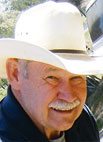
TMB Angus Ranch and Breeding Services, owned by Terry and Mary Brown, has been developed over the years to become the premier operation that it is today. They run 50 cow/calf pairs of registered Angus and raise registered Angus bulls on their 200-acre ranch near Leslie, Ark. They sell seedstock by private treaty. Their four grown children, Angela Thornburg, Chris, Terry Jr., and Travis Brown and six grandkids live in several different states.
“My grandfather, Roy Brown, was a farmer and cattleman in Iowa,” Terry said. “That’s where we lived when I was growing up.”
The tradition of cattle ranching continued with Terry’s father, Merle Brown. That heritage would go on to play an important role in Terry’s future cattle operation.
“In 1974 Dad bought this home place and we moved to Arkansas,” he said. “Our children grew up here and attended school in Marshall. I’m the only grandchild from the Brown family that wanted to live on a farm and raise cattle, and I’ve been in this business for 35 years. We started with Angus and we’ve probably turned over two or three cow herds. It takes about 10 years to turn a whole herd over until it’s 100 percent improved.”
The Breeding Business
In addition to the farm, there’s also the breeding business. Terry is a qualified AI technician and Mary goes with him on jobs as his assistant. They’ve discovered the biggest advantage to AI is that superior sires are made available to more than just a few select breeding operations. Semen from sires with proven genetic potential can be stored and shipped from around the world and can be introduced to cows over a greater distance, increasing the overall quality of the gene pool. Breeders also save on the expenses and headache often associated with feed, housing and pasture for a breeding bull. AI is insurance toward minimizing the risk against a herd bull going bad during breeding season. “There are several reasons to AI bred,” he said. “Usually you’re trying to improve something in your cattle. You’re targeting bulls with a reputation and they have thousands of calves on test. So, you identify the genetics that produce the better traits, such as calving ease, fast growth, maternal ability and excellent carcass traits. Another reason, when the packers and buyers are looking at your calves they want a uniform group. They want a set of calves that are all about the same size.”
Utilizing CIDRs with AI
In their own cattle operation and AI services for other cattlemen, Terry and Mary have learned that AI calves grade out better at the packing houses, when they’ve used the method called controlled internal drug release, (CIDR), for estrous synchronization for fixed timed AI. This system increases the number of females in estrus at one time. Females can conceive earlier in the breeding season, leading to more time between calving and weaning, helping create a uniform group of calves. The herd is tightened up, since less age variation produces calves that weigh out near the same size at sale.
“Fixed timed AI takes most of the guess work out of the calving season,” Mary said. “The cows all calve within a 10- to 21-day window.”
Why AI Works
Through the years Terry and Mary have discovered the value of AI. With tight controls exerted over the health of donor bulls and the technical procedures, risks for potential diseases are vastly reduced. Another important reason for AI breeding, a herdsman may not wish all calves to be sired by a single bull with the same characteristics. AI makes crossbreeding easier. Due to the convenience of being able to know in advance when a beef herd needs to be gathered for chute work, there is a huge savings in labor. Terry also raises good quality replacement heifers for other people and has built a good reputation that brings the buyers back.
“When cattlemen have smaller herds, it’s more important to have quality. Out of every animal they need the best potential they can possibly get to create their income.”
Terry also explained that’s why AI breeding works best, using semen from bulls that have proven to excel in some trait, to target that specific need for their herd. Once the genetics become part of the cowherd, the results continue to pay long-term dividends.
“Not many people can afford a $50,000 bull,” Mary said. “Most of them can afford a $25 straw of semen and get the highest quality genetics possible.”
Through years of experience, Terry and Mary have incorporated advanced cattle practices to produce quality Angus in their cow/calf production, and in the operations of other cattlemen.
“We help set up families who are just starting out raising cattle. I teach them what I know,” Terry said, “to pass along what I’ve learned to another generation of cattlemen.”







